
Shepherdstown is a town in Jefferson County, West Virginia, United States, located in the lower Shenandoah Valley along the Potomac River. Home to Shepherd University, the town's population was 1,734 at the time of the 2010 census.
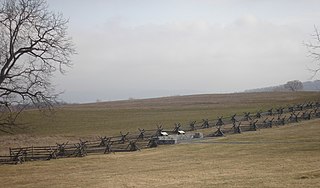
Antietam National Battlefield is a National Park Service-protected area along Antietam Creek in Sharpsburg, Washington County, northwestern Maryland. It commemorates the American Civil War Battle of Antietam that occurred on September 17, 1862.
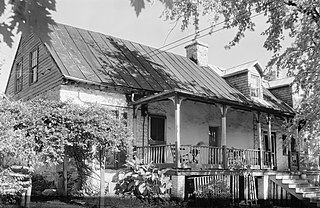
White House Farm, also known as White House Tavern and the Dr. John McCormick House, listed in the National Register of Historic Places, is located in Jefferson County, West Virginia, near the small town of Summit Point, about six miles from Charles Town, West Virginia. The farm consists of a ca. 1740 farmhouse, a stone barn, a springhouse of about the same age, a wooden curing shed, and 60+ acres of pasture and woods. The farm is one of the oldest in the county and has a rich history.

Alexander Robinson Boteler was a nineteenth-century planter turned businessman, as well as artist, writer, lawyer, Confederate officer, philanthropist and politician from Shepherdstown in what was initially Virginia and became West Virginia in the American Civil War.
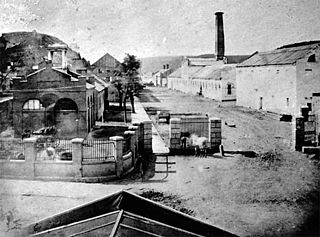
The Harpers Ferry Armory, more formally known as the United States Armory and Arsenal at Harpers Ferry, was the second federal armory created by the United States government. It was located in Harpers Ferry, Virginia. It was both an arsenal, manufacturing firearms, and an armory, a storehouse for firearms. Along with the Springfield Armory, it was instrumental in the development of machining techniques to make interchangeable parts of precisely the same dimensions.

Borough House Plantation, also known as Borough House, Hillcrest Plantation and Anderson Place, is an historic plantation on South Carolina Highway 261, 0.8 miles (1.3 km) north of its intersection with U.S. Route 76/US Route 378 in Stateburg, in the High Hills of Santee near Sumter, South Carolina. A National Historic Landmark, the plantation is noted as the largest assemblage of high-style pisé structures in the United States. The main house and six buildings on the plantation were built using this technique, beginning in 1821. The plantation is also notable as the home of Confederate Army General Richard H. Anderson.

Carter Hall was the Millwood, Virginia, USA estate of Lt. Col. Nathaniel Burwell (1750–1814). It is located in the upper Shenandoah Valley, off Virginia Route 255 northeast of Millwood. The estate includes a grand plantation house, a great lawn, and terraced gardens, and has panoramic views in all directions. It is listed on the National Register of Historic Places.

Claymont Court, or simply Claymont, is a Georgian-style brick mansion, the grandest of several built near Charles Town, West Virginia for members of the Washington family. The current "Big House" was built in 1840 for Bushrod Corbin Washington, nephew of Supreme Court justice Bushrod Washington and grand-nephew of George Washington, to replace the 1820 main house on his plantation that burned in 1838.

Elmwood is a Federal style house near Shepherdstown, West Virginia. Located on land claimed in 1732 by Edward Lucas II, it was built in 1797 by his son, Edward Lucas III. During the Civil War the house was used as a field hospital. It remained in the Lucas family until 1948.

Beverley, also known as Bullskin, is a farm near Charles Town, West Virginia that has been a working agricultural unit since 1750. The narrow lane that leads from U.S. Route 340 to the Beverley complex was, in the 18th and 19th centuries a toll road. The main house was built about 1800 by Beverley Whiting on the site of a c. 1760 stone house. The house is Georgian influenced Federal style, with a later Greek Revival portico. A number of outbuildings dating to the original 1760 house accompany the main house.

Falling Spring at Morgan's Grove is part of a related complex of buildings and lands associated with the Morgan family and other prominent members of the Shepherdstown, West Virginia, community.
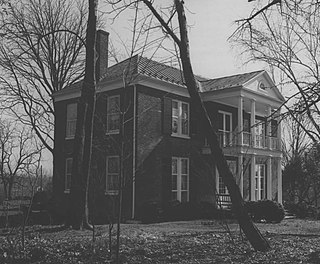
The Morgan-Bedinger-Dandridge House — first known as Poplar Grove, then Rosebrake or Rose Brake — is part of a group of structures affiliated with the Morgan's Grove rural historic district near Shepherdstown, West Virginia. The property was known as "Poplar Grove" until 1877.

The Shepherdstown Historic District comprises the historic core of Shepherdstown, West Virginia. The town is the oldest in West Virginia, founded in 1762 as Mecklenburg. No structures are known to exist from the time before the town became known as Shepherdstown. The historic district is concentrated along German Street, the main street, with 386 contributing resources and 69 non-contributing elements. The chief representative period is the late 18th century, with many Federal style brick houses. German Street is also furnished with 19th-century "street furniture" such as metal fences, mounting blocks, wooden pumps and mature trees.

The Jefferson County Courthouse is a historic building in Charles Town, West Virginia, USA. The building is historically notable as the site of two trials for treason: that of John Brown in 1859, and those of unionizing coal miners from Mingo County, West Virginia, a consequence of the Battle of Blair Mountain, whose trials were moved from the southern part of the state in 1922 as a result of a change of venue.

Traveller's Rest, also known as the General Horatio Gates Home, is an historic plantation house located on Bowers Road near Kearneysville, Jefferson County, West Virginia. Built in 1773 and enlarged a few years later, it was the home of Continental Army General Horatio Gates from 1773 until 1790. The house is very little altered from that period, and was designated a National Historic Landmark in 1972. The house is located on private property, and is not normally open to the public.

Mount Airy, also known as Grove Farm, is a historic home located at Sharpsburg, Washington County, Maryland, United States. It is a 2+1⁄2-story Flemish bond brick house, built about 1821 with elements of the Federal and Greek Revival styles. Also on the property are a probable 1820s one-story gable-roofed brick structure that has been extensively altered over time, a late-19th-century frame barn with metal roof ventilators, a 2-story frame tenant house built about 1900, and a mid-20th-century cinder block animal shed. It was used as a hospital for Confederate and Union soldiers following the Battle of Antietam. On October 3, 1862, President Abraham Lincoln and General George McClellan visited Mount Airy, an event recorded photographically by Alexander Gardner.

Union Historic District is a national historic district located at Union, Monroe County, West Virginia. The district includes 174 contributing buildings, 2 contributing sites, 7 contributing structures, and 1 contributing object in the Union and surrounding areas.
The Civil War Trust's Civil War Discovery Trail is a heritage tourism program that links more than 600 U.S. Civil War sites in more than 30 states. The program is one of the White House Millennium Council's sixteen flagship National Millennium Trails. Sites on the trail include battlefields, museums, historic sites, forts and cemeteries.

Morgan's Grove Park is located in Shepherdstown, West Virginia, United States, and shares a history dating back to the 18th Century and Morgan's Grove, from which the historic park got its name.
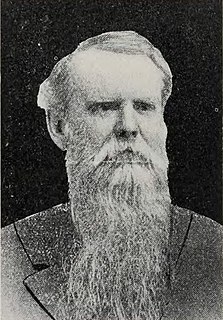
William Augustine Morgan was a Virginia planter from Shepherdstown who became a Confederate States Army cavalry officer throughout the American Civil War, then represented Jefferson County at the West Virginia Constitutional Convention of 1872 and served as the county's deputy sheriff for 26 years.






















